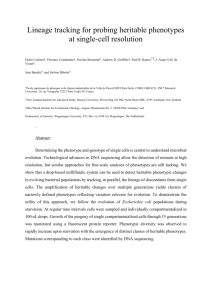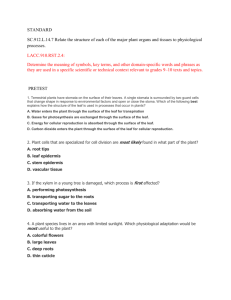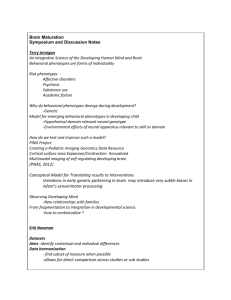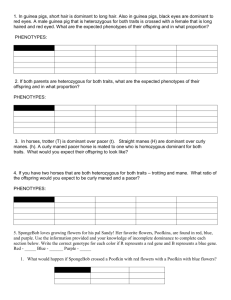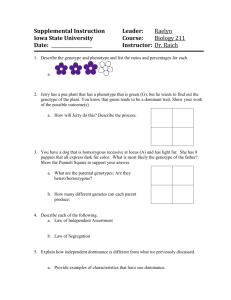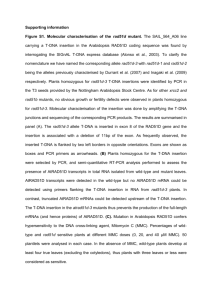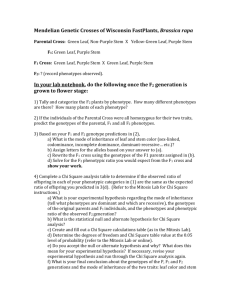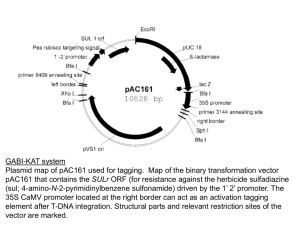TPJ_4721_sm_Legends
advertisement
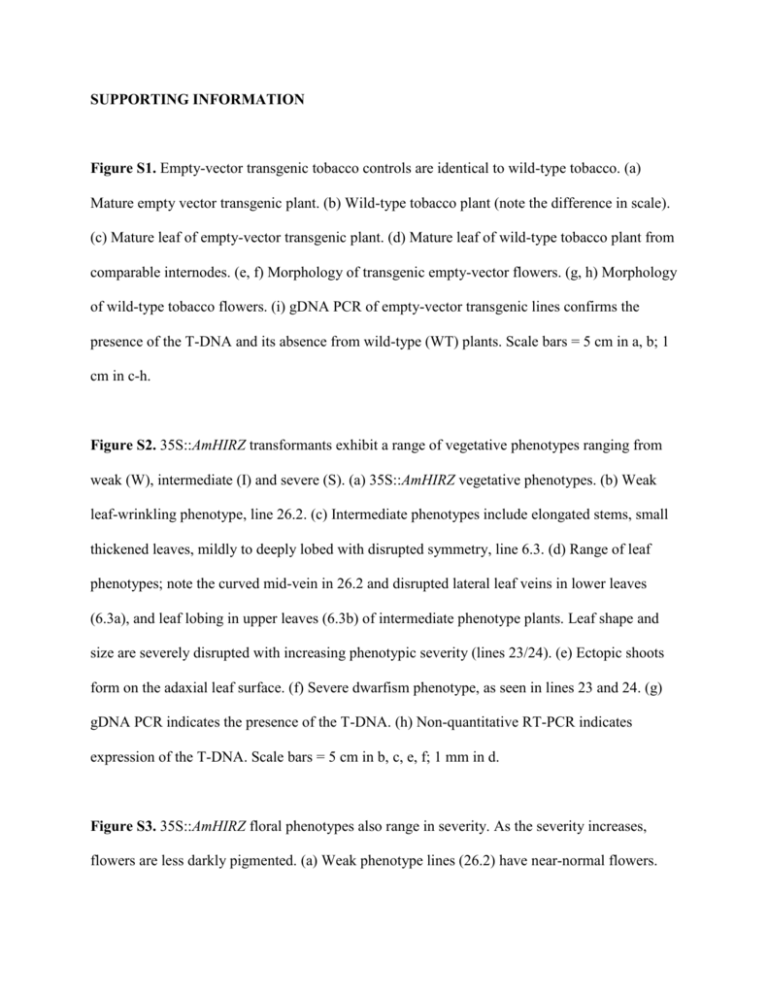
SUPPORTING INFORMATION Figure S1. Empty-vector transgenic tobacco controls are identical to wild-type tobacco. (a) Mature empty vector transgenic plant. (b) Wild-type tobacco plant (note the difference in scale). (c) Mature leaf of empty-vector transgenic plant. (d) Mature leaf of wild-type tobacco plant from comparable internodes. (e, f) Morphology of transgenic empty-vector flowers. (g, h) Morphology of wild-type tobacco flowers. (i) gDNA PCR of empty-vector transgenic lines confirms the presence of the T-DNA and its absence from wild-type (WT) plants. Scale bars = 5 cm in a, b; 1 cm in c-h. Figure S2. 35S::AmHIRZ transformants exhibit a range of vegetative phenotypes ranging from weak (W), intermediate (I) and severe (S). (a) 35S::AmHIRZ vegetative phenotypes. (b) Weak leaf-wrinkling phenotype, line 26.2. (c) Intermediate phenotypes include elongated stems, small thickened leaves, mildly to deeply lobed with disrupted symmetry, line 6.3. (d) Range of leaf phenotypes; note the curved mid-vein in 26.2 and disrupted lateral leaf veins in lower leaves (6.3a), and leaf lobing in upper leaves (6.3b) of intermediate phenotype plants. Leaf shape and size are severely disrupted with increasing phenotypic severity (lines 23/24). (e) Ectopic shoots form on the adaxial leaf surface. (f) Severe dwarfism phenotype, as seen in lines 23 and 24. (g) gDNA PCR indicates the presence of the T-DNA. (h) Non-quantitative RT-PCR indicates expression of the T-DNA. Scale bars = 5 cm in b, c, e, f; 1 mm in d. Figure S3. 35S::AmHIRZ floral phenotypes also range in severity. As the severity increases, flowers are less darkly pigmented. (a) Weak phenotype lines (26.2) have near-normal flowers. Lines 6.3 (b, e) and 9.2 (c, k) have almost normal flowers with ectopic sac-like outgrowths of tissue at the margins of the fused petals of the corolla tube. Intermediate floral phenotypes, e.g. line 9.2 (c, k) and 20 (i,j), have a shorter, dissected corolla tube. The corolla tube can be heavily wrinkled with numerous perturbations (d) and additional tissue growth (f). Flowers can be severely dissected (g) with wrinkled corolla tubes (h) e.g., line 17.2. Arrows indicate ectopic saclike outgrowths. Scale bars = 1 cm. Figures b-h were photographed at the same scale. Figure S4. Vegetative and floral phenotypes of 35S::AmINA transformants. (a) Range of vegetative phenotypes. (b, c) Leaves are small and wrinkled with a curved mid-vein (lines 3.1, 5, 10; b) and ectopic shoots on the adaxial leaf surface (line 4; c). (d-j) In weak-intermediate lines, e.g. line 3.1, flowers are almost normal (d) but with a reduced corolla tube, ectopic bulges (white arrow; e) and an exerted style (e, f). Severe phenotypes include crowded inflorescences and aborted buds (g, h). Flowers lack pigment, the petals fail to fuse (i) and anthers (red arrow in j) fail to elongate. (k) gDNA PCR indicates the presence of the T-DNA. (l) Non-quantitative RTPCR indicates expression of the T-DNA. Scale bars = 5 cm in a; 3 cm in b, c; 1 cm in d-j. Figure S5. Vegetative and floral phenotypes of 35S::LvHIRZ transformants. (a) Range of vegetative phenotypes. (b) In severe lines, such as line 5.1, leaves fail to develop and dwarfing is severe. (c) Leaves are small, wrinkled and have disrupted venation, with extensive lobing (line 5.2) and ectopic shoots on the adaxial leaf surface (line 1.1; c). In intermediate lines, such as lines 1.1 (d), 4.3 (e) and 6.2 (j), inflorescences are crowded, with many aborted buds (d, e). Flowers that do develop are smaller and narrower than wild-type and lack pigment (d, e, j). Although the corolla tube does elongate (d, e), the anthers (red arrows in d, e) remain short. In more weakly affected plants, the corolla tube may be bent, as in line 5.2 (f), or dissected (white arrows in h, i), as in lines 5.4 (g), 5.5 (h) and 6.3 (i), with reduced length. (j) gDNA PCR indicates the presence of the T-DNA. (k) Non-quantitative RT-PCR indicates expression of the T-DNA. Scale bars = 3 cm in c; 1 cm in b, d-j. Table S1. Primers used in this work. Sequences highlighted in bold face represent restriction sites added to primers. Degenerate base sequence Y = C/T, S = G/C, R = A/G.

